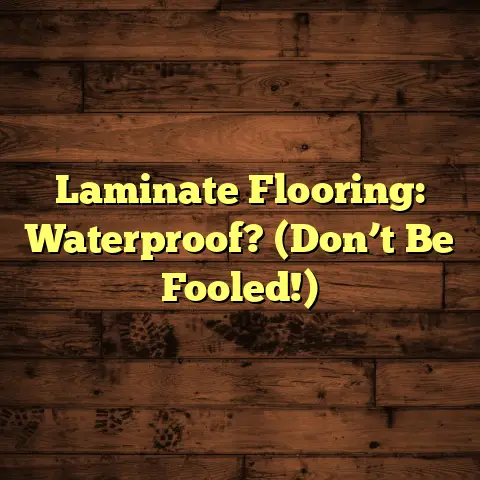Nail Polish on Tile: Pro Removal Tricks (3 Fixes)
I get it. We all love a splash of color in our lives, especially when it comes to expressing ourselves through hobbies like nail art.
I mean, who doesn’t love experimenting with the latest trends, from glittery gradients to intricate designs?
It’s a fantastic way to unwind and let your creativity flow.
But let’s be real, sometimes our artistic endeavors can get a little… messy.
Ever had that heart-stopping moment when a bottle of your favorite nail polish tips over, splattering onto your beautiful tile floor?
Yeah, I’ve been there. It’s like a mini-disaster zone right in your home!
While nail polish is great for adding that perfect touch to our nails, it’s a total pain when it decides to relocate to our tiles.
But don’t panic! I’m here to share some tried-and-true, professional tricks for removing nail polish from tile surfaces.
These methods will help you keep enjoying your hobbies without the constant worry of ruining your floors.
Let’s dive in and get those tiles looking spotless again!
Section 1: Understanding the Challenge
So, why is nail polish such a tough customer when it comes to cleaning it off tiles?
Well, it all boils down to its chemical composition.
Nail polish is essentially a blend of polymers, solvents, pigments, and resins.
These ingredients work together to create a durable, shiny coating on our nails.
But when that mixture lands on a porous surface like tile, it can seep into the tiny crevices and bond tightly.
Think of it like trying to remove dried paint from a textured wall – not fun, right?
Now, let’s talk tiles.
There’s a whole world of tile types out there, each with its own unique properties:
-
Ceramic Tiles: These are probably the most common. They’re durable, easy to clean, and relatively non-porous.
-
Porcelain Tiles: Similar to ceramic, but even denser and less porous, making them more resistant to stains.
-
Vinyl Tiles: These are softer and more flexible, which means they can be more susceptible to damage from harsh chemicals.
-
Natural Stone Tiles (like marble or granite): These are beautiful but also the most delicate. They can be easily stained and damaged by acidic or abrasive cleaners.
The type of tile you have will definitely influence how you approach nail polish removal.
For instance, what works wonders on porcelain might wreak havoc on natural stone.
Time is of the essence when it comes to nail polish spills.
The longer you wait, the more the polish sets and the harder it becomes to remove.
Think of it like letting cake batter dry on your counter.
It’s much easier to wipe up when it’s fresh, isn’t it?
Also, using the wrong cleaning methods can do more harm than good.
Aggressive scrubbing can scratch the tile surface, while harsh chemicals can discolor or even dissolve certain types of tiles.
Did you know? According to the Tile Council of North America (TCNA), improper cleaning is one of the leading causes of tile damage in homes.
That’s why it’s super important to choose your cleaning method wisely!
Section 2: Pro Removal Trick #1 – Acetone-Based Remover
Alright, let’s get down to business!
My first go-to trick for tackling nail polish stains on tile is using acetone-based nail polish remover.
Acetone is a powerful solvent that works by breaking down the polymers in nail polish, effectively dissolving it.
It’s like the superhero of nail polish removal!
Step-by-Step Guide:
-
Test a Small Area: Before you go all-in, grab a cotton swab and dab a little acetone on an inconspicuous area of the tile. Wait a few minutes to see if there’s any discoloration or damage. This is crucial, especially for natural stone or vinyl tiles.
-
Gather Your Supplies: You’ll need:
- Acetone-based nail polish remover
- Cotton balls or a soft cloth
- Clean water
- A clean cloth for rinsing
- Gloves (optional, but recommended)
-
Apply Acetone: Soak a cotton ball or cloth with acetone. Gently dab it onto the nail polish stain. Let it sit for a minute or two to allow the acetone to start dissolving the polish.
-
Gently Wipe: Using a clean part of the cloth or a fresh cotton ball, gently wipe away the softened nail polish. Avoid scrubbing too hard, as this can damage the tile surface.
-
Repeat if Necessary: For stubborn stains, you might need to repeat steps 3 and 4 a few times. Be patient and persistent!
-
Rinse Thoroughly: Once you’ve removed the nail polish, rinse the area with clean water to remove any acetone residue.
-
Dry the Area: Use a clean, dry cloth to wipe up any excess water.
Safety Precautions:
-
Ventilation is Key: Acetone fumes can be strong, so make sure you’re working in a well-ventilated area. Open a window or turn on a fan.
-
Wear Gloves: Acetone can dry out your skin, so wearing gloves is a good idea.
-
Keep Away from Flames: Acetone is flammable, so keep it away from open flames or sources of ignition.
Aftercare:
After using acetone, it’s important to clean the area thoroughly to remove any residue.
I usually like to use a mild soap and water solution, followed by a clean water rinse.
This will help restore the tile’s shine and prevent any potential discoloration.
Personal Story:
I remember once, I accidentally spilled a whole bottle of bright red nail polish on my light-colored ceramic tiles.
I was mortified! I immediately grabbed my acetone-based remover and followed the steps I just outlined.
To my relief, the stain came right off without any damage to the tiles.
Did you know? Acetone is also used in many industrial cleaning processes due to its powerful solvent properties.
Section 3: Pro Removal Trick #2 – Rubbing Alcohol
If you’re a bit wary of using acetone, or if you’re dealing with a more delicate tile type, rubbing alcohol (isopropyl alcohol) is a fantastic alternative.
It’s a gentler solvent that can still effectively break down nail polish, especially if you catch the stain early.
Step-by-Step Guide:
-
Test a Small Area: Just like with acetone, start by testing a small, hidden area of the tile to ensure it doesn’t cause any damage or discoloration.
-
Gather Your Supplies: You’ll need:
- Rubbing alcohol (70% or higher is recommended)
- Cotton balls or a soft cloth
- Clean water
- A clean cloth for rinsing
-
Apply Rubbing Alcohol: Soak a cotton ball or cloth with rubbing alcohol. Gently dab it onto the nail polish stain. Let it sit for a few minutes to allow the alcohol to penetrate the polish.
-
Gently Wipe: Using a clean part of the cloth or a fresh cotton ball, gently wipe away the softened nail polish. You might need to apply a bit more pressure than with acetone, but still avoid scrubbing too hard.
-
Repeat if Necessary: For stubborn stains, repeat steps 3 and 4 until the stain is completely removed.
-
Rinse Thoroughly: Once you’ve removed the nail polish, rinse the area with clean water to remove any alcohol residue.
-
Dry the Area: Use a clean, dry cloth to wipe up any excess water.
Effectiveness:
Rubbing alcohol works best on fresh nail polish stains and on certain types of nail polish.
For example, cream polishes tend to respond better to rubbing alcohol than glitter polishes, which can be more difficult to dissolve.
Why? Glitter polishes contain tiny particles that are resistant to solvents, making them harder to remove.
Safety Precautions:
-
Ventilation: While rubbing alcohol is less potent than acetone, it’s still a good idea to work in a well-ventilated area.
-
Tile Compatibility: Rubbing alcohol is generally safe for most tile types, but it’s always best to test a small area first, especially with natural stone.
Personal Experience:
I’ve found rubbing alcohol to be particularly useful for removing nail polish spills from vinyl tiles.
It’s gentle enough not to damage the surface, yet effective enough to lift the stain.
Did you know? According to a study published in the Journal of Environmental Health, rubbing alcohol is an effective disinfectant and can also help remove stains from various surfaces.
Section 4: Pro Removal Trick #3 – DIY Baking Soda Paste
For those who prefer a more natural and eco-friendly approach, baking soda is a fantastic option.
This humble household staple is a mild abrasive that can help lift nail polish stains without harsh chemicals.
Recipe and Application:
-
Create the Paste: Mix baking soda with a small amount of water to form a thick paste. The consistency should be similar to toothpaste.
-
Apply to Stain: Apply the baking soda paste directly onto the nail polish stain. Make sure to cover the entire area.
-
Let it Sit: Allow the paste to sit for 15-20 minutes. This gives the baking soda time to penetrate the stain and start breaking it down.
-
Gently Scrub: Using a soft-bristled brush or a clean cloth, gently scrub the stain in a circular motion. Avoid applying too much pressure, as baking soda can be mildly abrasive.
-
Rinse Thoroughly: Rinse the area with clean water to remove all traces of baking soda paste.
-
Dry the Area: Use a clean, dry cloth to wipe up any excess water.
Effectiveness and Benefits:
Baking soda is a great choice for those who are sensitive to chemicals or who have delicate tile surfaces.
It’s particularly effective on ceramic and porcelain tiles.
Benefits:
-
Eco-Friendly: Baking soda is a natural, non-toxic cleaning agent.
-
Gentle: It’s less likely to damage or discolor tile surfaces compared to harsh chemicals.
-
Readily Available: You probably already have baking soda in your pantry!
Post-Cleaning Care:
After using baking soda paste, it’s important to rinse the area thoroughly to ensure that no residue remains.
Baking soda can leave a white, powdery film if not rinsed properly.
Personal Story:
I once used baking soda paste to remove a stubborn nail polish stain from my kitchen floor.
I was amazed at how well it worked, especially considering it’s such a simple and natural solution.
Did you know? Baking soda is also used in many commercial cleaning products due to its natural cleaning and deodorizing properties.
Conclusion
So, there you have it! Three pro-level tricks for tackling nail polish spills on your beautiful tile floors.
Remember, hobbies like nail art are all about self-expression and enjoyment.
Don’t let the fear of a little mess hold you back from pursuing your passions.
With the right techniques and tools, you can easily manage any cleanup challenges that come your way.
Whether you choose to use acetone, rubbing alcohol, or baking soda, the key is to act quickly, test in a small area first, and be gentle with your tiles.
And most importantly, don’t forget to have fun!
With these pro removal tricks in your arsenal, your tiles can stay pristine, allowing you to focus on what truly matters: enjoying your hobbies.
So go ahead, unleash your creativity, and don’t sweat the small stuff.
Happy crafting!





